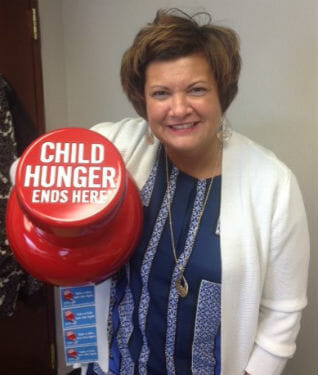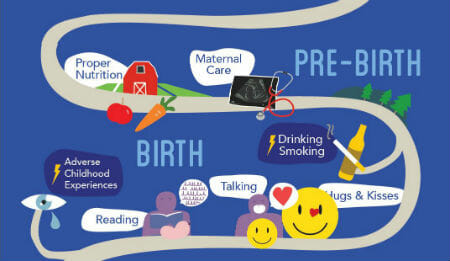What’s Your Path for Change? Here’s One to Try
This post is by Kori Reed, vice president of cause and foundation for ConAgra Foods.
Mahatma Gandhi’s teachings tell us: “Be the change you want see.”
 Kori Reed holds an oversized push pin promoting ConAgra Foods’ Child Hunger Ends Here campaign.
Kori Reed holds an oversized push pin promoting ConAgra Foods’ Child Hunger Ends Here campaign.OK, but that’s not always easy to do. Where do we start? Where is the path?
Those are questions many of us ask ourselves – and struggle with. Including me. I have found some answers in “A Path Appears,” a book about evidence-based ways to create opportunity among our world’s most vulnerable, those in poverty.
In the book, award-winning journalists Nicholas Kristof and Sheryl WuDunn sound a call to action for individuals, communities and corporations alike, to be courageous and show kindness by helping others. (The book also showcases the personal benefits of volunteer work. Helping others really helps us, too!)
Kristof and WuDunn based the book title on a Chinese proverb about a path that becomes more visible the more it is walked upon. On the path to happiness for each person there are a number of milestones – starting with Warren Buffett’s Ovarian Lottery concept (the idea that your lot in life hinges to a large degree on your birth) – and detours. Therefore, it also can be a roadmap to take action to help progress.
When I read the book, and as a visual learner, I wondered whether it was possible to capture all these lessons, research and evidence in one page. I reached out to WuDunn to develop the map of a path, a kind of a Chutes and Ladders for life.
 A segment of the what Kori Reed calls “a kind of a Chutes and Ladders for life”
A segment of the what Kori Reed calls “a kind of a Chutes and Ladders for life”Why? I hope it shows how possible it is for us all to be kind and help a person at any point on the path, and ultimately, do our part to break the cycle of poverty – a large, complex issue that so encumbers our society and societies around the world.
The authors include the role of business in creating these pathways, and that hit the sweet spot for me. At ConAgra Foods, where I work, we know so well how hunger at a young age can harm a child’s chances for future growth, both physically and mentally.
The greatest gift we can give is opportunity. So, here’s hoping this visual path gives people the courage to jump in and sparks an idea for how to be kind to others in a way that creates opportunity for all.
More importantly, walking the path again and again will help others see it more clearly and spark catalytic change.
Have courage. Be kind.
